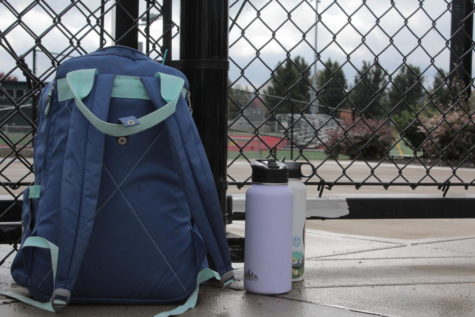Cultural dress code: a discussion
A look into the dress etiquette of different cultures
Photo courtesy of Meileen Arroyo
Junior Tasneem Jabrah explains that everyone has implicit biases that impact the way they perceive others but it’s their responsibility to humanize those that dress modestly or immodestly. “I understand you’re showing your skin because you feel like it, and not because you want to give anybody attention just like how I’m wearing what I want to wear for me,” Jabrah said. “I mind my business and I hope people do the same for me.”
April 5, 2022
Why do we dress the way we do? The answer seems obvious, “because it’s my style and I like it. What else?” A few weeks ago, I wore a slightly bolder outfit and was planning on wearing it to school. My intuition told me to pick out another outfit because deep down I knew my implicit bias was telling me that what I was wearing wasn’t “acceptable.” I had a feeling I would face disapproval from my parents solely because my skirt was “too short” or I was showing more skin than normal. I headed downstairs and was greeted by my mom who gave me her best Mexican mom glance that read, “you’re really going to wear that.” I knew exactly what to respond to her without the need for her to verbally tell me. My automatic response was, “I can go change.”
There were two sides to my thought process. One: I could’ve stepped out of my comfort zone and worn the skirt with confidence or two: I could change because my outfit was “problematic” not for school but for my mom’s, my own, and most importantly my culture’s principles, rules, ideology, and dress etiquette.
Machismo is a strong sense of masculine pride. Latin culture is a male-dominated culture where women are seen as inferior and are expected to obey their male counterparts. On the feminine side, Marianismo, hyper-femininity, is the counterpart of machismo in which women exhibit the traditional gender roles of Latin culture: remaining abstinent until marriage, putting their family’s needs over their own, following their husbands orders, taking care of the family, and being submissive to their husbands and only their husbands. Machismo and marianismo perpetuate the concept of toxic masculinity in today’s generation. The idea that men are “superior” to women teaches young boys that real men control and young girls that a woman must receive and accept control from the men in their life.
The way in which we dress often stems from our own household; not everyone who belongs to the same culture group will have the same beliefs and perspective regarding clothing, however, every culture does have its own dress etiquette solely made for women. Oftentimes, first-generation daughters have a more modernized way of thinking and dressing that may not align with the traditional ways of being a woman that is instilled into the minds of immigrant parents since birth. This cultural clash between immigrant parents and first-generation daughters is another factor, along with machismo, that impacts the dress etiquette for Latin women. The dress etiquette in Latin culture for women consists of clothing that is less “attention seeking” and less revealing, due to one of the biggest fears that immigrant parents, especially immigrant mothers have.
PSU college student, first-generation Hispanic daughter, and my sister, Jessica Arroyo, gives insight on the cultural clash between Hispanic fathers and their daughters.
“I think for a lot of women going out is [a struggle]. If your parents see you go out with certain friends, they first look at what you’re wearing and then decide if you can go or [if] you have to change first before [heading out],” Arroyo said. “Especially for fathers, they don’t think it’s acceptable for a woman to be wearing certain clothing when they go out because it gives off the idea that they’re doing something they aren’t supposed to, or that something dangerous might happen to them especially when they’re not around.”
Junior and MEChA officer, Kiara Salas Moreno, shares her experience as a young Latina woman in social settings.
“Being a young girl, out and about, I’ve had instances where I feel uncomfortable wearing those clothes because peers or men have made comments about what I’m wearing, my body, or they just give me uncomfortable looks,” Salas shared. “As a result, I don’t feel comfortable wearing those clothes anymore.”
The idea that provocative clothing results in sexual assult, violence, physical/sexual conduct, and other “unlady like” behaviors is prepetuated in Latin culture. This idea along with the expectation that Latina women should remain abstinent and pure until marriage keeps the dress code alive. Latin culture is very family-oriented: family comes first, always. With this also comes control, the power dynamic between parents and their children is an internal battle that every family deals with. When it comes to Latin culture, parents approve or disapprove certain clothing in order to prevent risky situations from occurring. These actions may come from a good place of parenting but the message that these actions suggest leads to increased oppression of women’s clothing and over-sexualization of women’s bodies, especially women of color.
Arroyo talks about the ways in which she was controlled by her own family.
“My mom used to pick out my clothes from elementary to middle school. I feel like her opinion really influenced the way I dressed during those times and even now I still get comments about what looks good or doesn’t look good on my body type” Arroyo said. “Specifically for me when I was younger, I would wear dresses to parties and there were certain comments that my dad would make.”
Those comments would criticize how she should sit when wearing certain clothes to look more ladylike and proper.
Ethnicity is one factor that makes up your cultural identity. However, religion is also a common form of cultural expression in our society. According to the text article “Islam – Five Pilars, Nation of Islam & Definition” on the website History.com, “Islam is the second largest religion in the world after Christianity, with about 1.8 billion Muslims worldwide.” There is often criticism by people who are not Muslim regarding the unfair treatment of women in Islam, however, unlike Latin culture Islam has similar dress etiquette rules from men and women.
Junior and President of MSA: Muslim Student Association and MENA: Middle Eastern North African, Tasneem Jabrah, speaks on the dress code in her ethnic and religious culture.
“[In Islam] women dress modestly. We have to cover our arms and our legs and the same thing goes for men,” Jabrah said. “There is less equality within [my] Middle Eastern culture. For Islam it’s different, women are held to a very important standard.”
There is a false stereotype in society that targets the sacred and symbolic clothing piece for Muslim women. There is this idea that is perpetuated in society about men forcing women to wear the hijab and dress modestly, however, these are both choices that each individual makes which can be influenced by a number of reasons ranging from: preserving their beauty, feeling safe, representing their religion etc. Although, the choice of wearing the hijab is a decision made by women the rule of dressing modestly in Islam creates feelings of restriction in young girls. Growing up in a western culture with a “less” strict dress code Muslim women and women of color in general are left to feel alienated, out of place, and not accepted.
Jabrah talks about her own mental and emotional restriction.
“[Growing up] I was in swimming, soccer, basketball, and even cheerleading and it’s really hard to find a space where I’m accepted. With cheerleading I had to wear leggings under my uniform and it was very hard because it felt like nothing really accommodated to how I had to dress,” Jabrah said. “I felt like the way that I dressed restricted me from feeling normal and feeling like I could be a part of a lot of things. Even though I’m very confident with my scarf right now, sometimes I still feel like it restricts me from living normally.”
School is another factor that causes feelings of mental, emotional, and physical restriction on young girls. Smaller events like spirit weeks and crazy hair days may seem not harmful to most of us, however, for Muslim girls, like Jabrah, these events are another form of restriction.
“It’s little things like that, that showed me that I don’t matter and that I [couldn’t] really be normal. This led me to taking off my scarf in sixth grade because I noticed how much I was less restricted when I took it off. It felt like if I did take it off then I would be a member of society.”
School dress code controversies are increasing nationally. There are countless instances where girls have been targeted through their schools dress code policies and have been affected disproportionately in comparison to boys. According to page 12 of the student handbook copy of 2021-2022, “Students have the right: To dress and groom according to their choice consistent with the goals and purpose of the educational environment.” Tigard’s dress code has no clear rules on the type of clothing students can wear the only limit includes: “Articles of clothing that advertise illegal activities or promote the use of alcohol, tobacco, or drug products, promote acts of violence and/or intimidation, or that display sexually suggestive words or pictures.”
Salas gives her general thoughts on the dress code policies in schools.
“Dress code policies in general, limit creativity and target girls [and] women. It’s frustrating to see that there are policies [that] prohibit women to not show their shoulders, as well as prohibiting women and men from wearing certain hairstyles,” Salas said. “It restrains self-expression. It restrains people from being able to fully express who they are whether it’s wearing something that honors their culture or their passions.”
In today’s society, we have started to see a rise in the ideology and social-movement of feminism lead by today’s youth. Women of all ages, sizes, and races are paving the way for a more equitable world for future generations. There is still a way to go, but it all starts within. Realizing that there is no normal, realizing that there will be people that talk, people that judge you because of what you wear, people that control you. I’ve just now started to learn and accept that I can’t change the way others think or behave but I do have control over myself.
Jabrah shared her journey with her hijab and why she decided to put her scarf back on after some time having it off. She felt as though it hurt her more not having her hijab than having it on. She realized that her faith is a huge part of her life and that her hijab represented a part of her. Jabrah’s hijab and clothing is a form of safety and protection for her.
“There’s always going to be a person that thinks you’re a slut or an extremist because of what you’re wearing. It’s really hard to find that middle and so I realized I’m never going to find that middle, I’m never going to be normal. So I might as well just dress however I want to dress.”



















